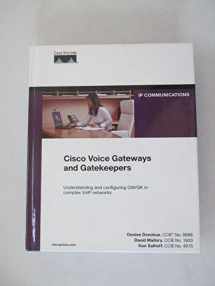
Cisco Voice Gateways And Gatekeepers
Book details
Summary
Description
Preface Foreword Cisco IOS routers have shipped with voice interface cards since 1997, and after this capability was available the term voice gateway became part of the VoIP vernacular, seemingly overnight. The voice interfaces allowed routers to provide a critical interconnectivity link between the traditional data IP networks and the traditional voice PSTN, PBXs, and key systems networks. With this technology, the industry widely built toll bypass networks during the late 1990s: Enterprises connected their PBXs at different sites with VoIP "trunks" instead of with TIE lines or the PSTN, and service providers leveraged IP backbone networks to offer calling-card services and cut-rate long-distance and international calling. VoIP did not fascinate the popular imagination of the likes of Jeff Pulver of Voice-on-the Net VON and other industry observers until end-user-visible devices, such as IP phones, and IP-based applications brought the technology to the forefront. Voice gateway technology is still the pale sibling of the IP telephony world that creates no buzz, and yet it is also the workhorse of every single VoIP network. Even as VoIP endpoints become ever more prevalent in businesses and residences, voice gateways still provide critical interconnectivity with billions of traditional PSTN and PBX voice endpoints, without which companies cannot operate their communications networks. Although the idea of a voice gateway is conceptually simple enough-it's a demarcation between two networks and translates the protocols from one the TDM world to the other the IP world -the technology has become increasingly sophisticated and the features more intertwined over the years. Choosing the "right" voice gateway and configuring the "right" set of features for a particular network is no longer the task for the uninitiated. The question I hear most frequently is whether to deploy MGCP, H.323, or SIP gateways. Cisco gateways are protocol agnostic and support all of these protocols and several variations thereof, and the answer to the question posed is not a simple one: The optimal network design depends on a large number of considerations. Some protocols and designs are better suited to particular types of networks, partly owing to the architecture of the protocols themselves and partly due to the features that have been chosen for implementation over the years. A Cisco Press book with comprehensive coverage focused entirely on voice gateway technology and features was a long time coming, and at last with this book, the authors provide an in-depth look at the breadth of voice gateway features and capabilities, as well as providing voice gateway configuration guidance. The book explains the major VoIP protocols, MGCP, H.323, and SIP, their structure and operation, and the considerations to choose among them. It discusses in detail the PSTN and PBX circuit connection technologies and choices. There are often multiple connection choices on the central office or PBX switch as well as on the voice gateway side of the circuit, and which of these would provide the features, cost points, and manageability that are optimal for your network might not be obvious at first glance. The book goes on to provide insights into many other areas of gateway selection and deployment, including the myriad choices in carrying fax and modem traffic over IP, dial plan features and digit manipulation tools, call admission control capabilities to keep voice traffic off the IP network when it does not have the quality levels to carry it, a review of DSP technology and operation, and an examination of IP connectivity implications and QoS features required to carry voice traffic with decent quality. Later chapters in the book also include discussions on pure IP-oriented topics such as TCL and VXML applications capabilities, conference mixing, transcoding, gatekeeper functions and connectivity, and IP-to-IP gateway session border controller services and features. All of these pure VoIP services are offered by the same platforms that are also voice gateways, even though TDM connectivity is not a necessary component for the IP-only services. The book also covers key areas of interest in any network, including security measures and high availability. VoIP network security is a wide topic fully deserving of its own book-length treatment, but this book provides enough basic information to get your network deployed. It covers how voice gateway traffic passes through firewalls and NAT devices, how to encrypt voice signaling and media traffic to or from a voice gateway, as well as configuring class of service restrictions such that certain call patterns are allowed while others are blocked per the policy of your network. High availability is essential in all networks-a chapter in this book is dedicated to the discussion of how gateways fail over when other network components are out of contact, as well as how gateway features interoperate with IP Phone failover features such as SRST to maintain dial tone and PSTN network access for your end users at all times. Throughout the book is a case study that solidifies the chapter discussions by providing practical, hands-on examples of how the configuration of the system implements the features. This, together with the detailed chapter-by-chapter coverage of crucial gateway topics, make this an invaluable book essential to the tool chest of anyone contemplating the implementation of a new network, actively designing a network, or evolving or optimizing the features in an existing network. Christina HattinghAccess Technology GroupCisco Systems, Inc.


We would LOVE it if you could help us and other readers by reviewing the book
Book review



